Discovering the right music manager and player for Windows can often feel like looking for a needle in a haystack. With MusicBee, a free music player and library organizer, I’ve found it seamlessly bridges the gap between extensive music collection management and high-fidelity playback. MusicBee distinguishes itself by supporting a broad range of audio formats and features in a user-friendly interface, making it an indispensable application for anyone looking for the best listening experience. I find MusicBee is great for those who are either intimidated by applications such as foobar2000 or just find other media players too cumbersome to use.
My usage of MusicBee reveals it is much more than a conventional music player and manager. It goes above and beyond by offering in-depth tagging support for metadata, integration with Last.fm, CD ripping/burning support, file conversion support, and optimization for high-end soundcards and DACs. Additionally, MusicBee’s interface is highly customizable, and additional functionality can be added via plugins. All these features position it as a standout choice for those who prioritize both audio quality and music collection organization. Let’s dive deeper into what makes MusicBee a pivotal asset for music enthusiasts.
This MusicBee guide will look at some of the key features of MusicBee, as well as an overview of the interface and the music management and playback capabilities. After that, I’ll guide you through how to setup MusicBee to get the best experience possible, as well as my personal layout and various plugins and skins that I use.
Here’s a closer look at what makes this music manager and player stand out:
- Extensive Audio Format Support:MusicBee handles a wide range of audio formats, including but not limited to MP3, FLAC, ALAC, WAV, MQA, AAC, and OGG.
- Advanced Library Management:The software excels in organizing music collections with tools that allow for finding, renaming, and organizing tracks based on audio tag values. As well, it has excellent support for reading existing ID3 tags audio files.
- Customization and Integration:
- Visual Customization:From custom skins to music visualizations, MusicBee offers extensive options to personalize its appearance.
- Functional Add-ons:The ability to extend functionality through plugins, such as musicbee upnp for UPnP/ DLNA device support and DiscordBee for sharing what I’m listening to on Discord, enhances the overall experience.
- Playback Enhancements:Features like gapless playback and ReplayGain, and WASAPI and ASIO provide a seamless and consistent audio experience.
- Device Sync: MusicBee can sync your music library with most devices that present themselves as mass storage devices to Windows. This includes MTP devices (such as Android smartphones and DAPs), USB drives, and SD Cards.
These key features, among many others, position MusicBee as a highly versatile and user-friendly music manager, catering to both organizational needs and audiophile preferences.
MusicBee’s User Interface
MusicBee’s user interface (UI) is where functionality meets personalization, making music management not just efficient but also a visually pleasing experience. MusicBee’s UI is designed to cater to both the aesthetic preferences and functional needs of its users, ensuring a seamless interaction with their music library. Here’s an in-depth look at the UI’s standout features:
Customization at Its Core:
- Skins: You can dramatically alter the look of MusicBee by selecting from pre-existing skins or downloading new ones directly from the MusicBee website. This flexibility allows for a personalized music player that reflects one’s style.
- Layout Customization: The UI layout is highly adaptable, with options to modify panel layouts, information displayed, and overall appearance. Whether you prefer a minimalistic look or a more detailed view with album art and detailed metadata, MusicBee accommodates all.
Advanced Audio Features:
- DSP Settings: Various DSP options are available, along with the ability to import Winamp DSP plugins.
- Upmix and Resampling: There are also options to resample tracks to a preferred sample rate, as well as upmixing the stereo output to 5.1 surround.
- Audio Output: As mentioned earlier, MusicBee can take advantage of WASAPI (both Shared and Exclusive), and supports ASIO drivers, so that you can take full advantage of your audio hardware.
Navigation and Control:
- Intuitive Navigation: The UI is divided into logical sections – a left-hand side for navigation (Library, Playlists, Devices, and Plugins), a central grid for album artwork, and a right-hand side for playlist and metadata details. This layout makes it easy to manage and explore your music collection.
- Playback Controls: Located at the bottom, the main controls (Play, Pause, Stop, Previous, Next, and Shuffle) are easily accessible, ensuring smooth playback.
MusicBee’s UI stands out not just for its aesthetic adaptability but also for its thoughtful design that places user experience at the forefront. Whether you’re a casual listener or an audiophile, the interface offers a level of customization and control that transforms music management into a personalized journey.
Advanced Music Management
Exploring MusicBee’s advanced music management capabilities, I’ve discovered a suite of features that significantly enhance the organization and personalization of my music library. Here’s a breakdown of these advanced features:
Library Organization and Metadata Editing:
- MusicBee allows for meticulous organization of music libraries by attributes such as artist, album, genre, and more.
- The software’s extensive metadata editing capabilities let users modify tags directly within the player, ensuring accurate and comprehensive track information.
- Automatic artwork download enriches the visual appeal of each track, making the library aesthetically pleasing.
Dynamic Playlists and Audio Customization:
- Users can create dynamic playlists based on criteria like last played or highest rated, ensuring a personalized listening experience.
- A 10-band and 15-band equalizer, along with sound effects such as reverb, echo, and flanger, allows for fine-tuning of audio output.
- Crossfading support ensures smooth transitions between tracks, enhancing the overall listening experience.
Integration and Synchronization:
- Last.fm integration allows for scrobbling of listening history, adding a social dimension to music management.
- Podcast support enables users to manage and play their favorite podcasts directly from MusicBee.
- The ability to sync music libraries across multiple devices ensures access to your music collection anywhere, anytime. Android Wifi sync is also available.
These advanced features, coupled with MusicBee’s user-friendly interface, make it an unparalleled tool for managing and enjoying music on Windows platforms.
Additional Features and Integrations
Diving deeper into MusicBee’s ecosystem, the additional features and integrations it offers not only enhance the music listening experience but also foster a community of users and developers. This section explores the myriad of add-ons and support systems that make MusicBee a comprehensive music manager and player.
Add-ons and Customization:
- Skins and Themes:Choose from a wide array of skins to personalize the aesthetic of your music player.
- Plugins:Extend functionality with plugins like lyrics finders, streaming service integrators, and more.
- Visualizer and Theater Mode:Enhance your listening experience with visual elements that react to the music.
- Miscellaneous Add-ons:From mini-players to advanced tagging tools, the variety caters to all needs.
Community and Support:
- Forums:Engage in discussions, seek help, or report bugs in dedicated sections.
- MusicBee Wiki:A comprehensive knowledge base for all MusicBee-related queries.
- Developer API:For those interested in creating extensions, MusicBee provides a robust API.
User Engagement:
- MusicBee Wishlist:Users can request features for future versions, making it a community-driven project.
- Tips and Tricks:Share and discover user-to-user advice for optimizing MusicBee’s use.
MusicBee’s ecosystem is not just about playing music; it’s about creating a personalized and community-supported experience for every user.
Installation and Library Setup
Let’s look at the basic install and setup. MusicBee caters to a broad spectrum of needs with its three versions: Installer, Portable, and Microsoft Store version. Here’s a step-by-step guide to getting started:
Installation Process:
- Navigate to the MusicBee website to download the version that best suits your needs, and install it as you would any other Windows application.
Choosing the Right Version:
- TheInstaller versionis highly recommended for its ease of maintenance and traditional installation and options.
Setting Up Your Library:
- After installation, MusicBee will prompt you to select the method of importing your music files. This step is crucial for building your library. In my case, they are stored in two folders on a network drive I have mapped to my computer.
- You have the option to let MusicBee scan your entire music folder or specify particular directories. Importantly, MusicBee does not relocate your files; it merely links to their existing locations.
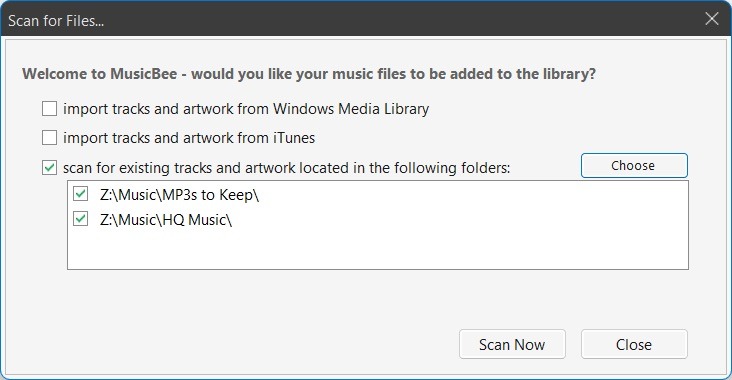
Click “Scan Now” and wait until it has finished scanning all your files.
Now your music library is imported into MusicBee you are free to listen to and enjoy your music.
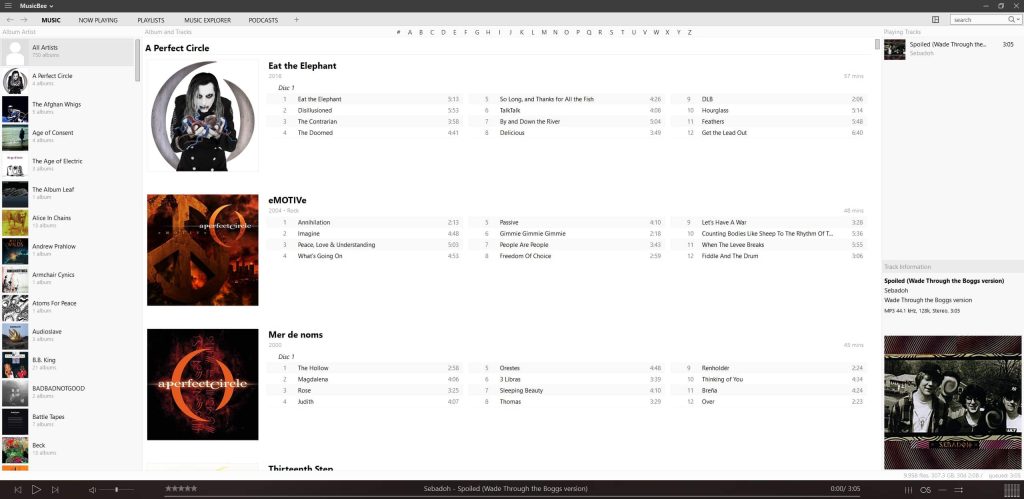
Customizing the Interface and Theme
While you might be content with the default theme and layout of MusicBee, you can go a step further and fine-tune it to your liking. Let’s tackle the theme, or “skin”, first.
MusicBee Skins:
- To select one of the included skins, click the hamburger menu on the very top left of the window, navigate to “Select Skin” and from there try out the various skins you think you will like.
- The skin I’ve been using for years now is the “Fluenx Dark – HiDPI Supported“. This skin is great as I prefer my apps to have a dark theme, and it supports high-resolution monitors very nicely.
- To add a new skin, download and extract the zip file from your desired skin, select “Add skin”, navigate to the .xmlc file in the extracted folder and click “Open”. If you want to use the same skin as me, look for the file “Fluenx Dark – Segoe UI – With Stop Button.xmlc”.
- MusicBee will restart once a new skin is selected.
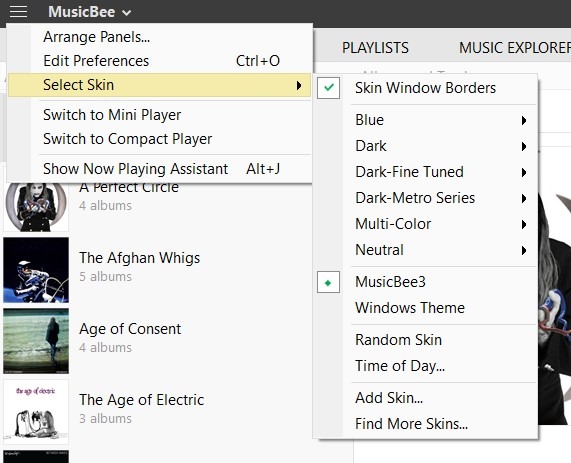
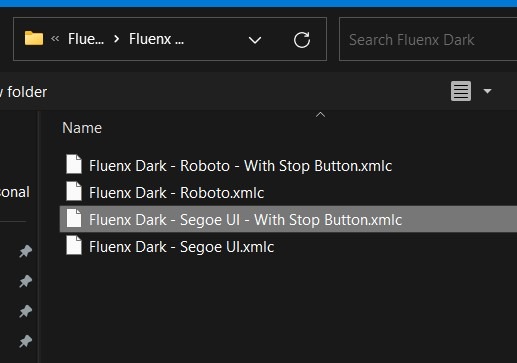
MusicBee Layout:
The default layout of MusicBee is extremely usable and intuitive, but it can be easily tweaked to suit your liking.
- Navigate to the MusicBee drop-down menu on the top left to “Edit”, and “Edit Preferences”.
- Select the tab Layout (1). From here you can change the font and font size that is used, decide what tabs show in the navigation bar, and configure various other options for each panel, which is how the MusicBee interface is organized.
- Select “Arrange Panels” and you have even more customization options. This is the section where you can do things such as moving the playback controls from the bottom of the window to the top.

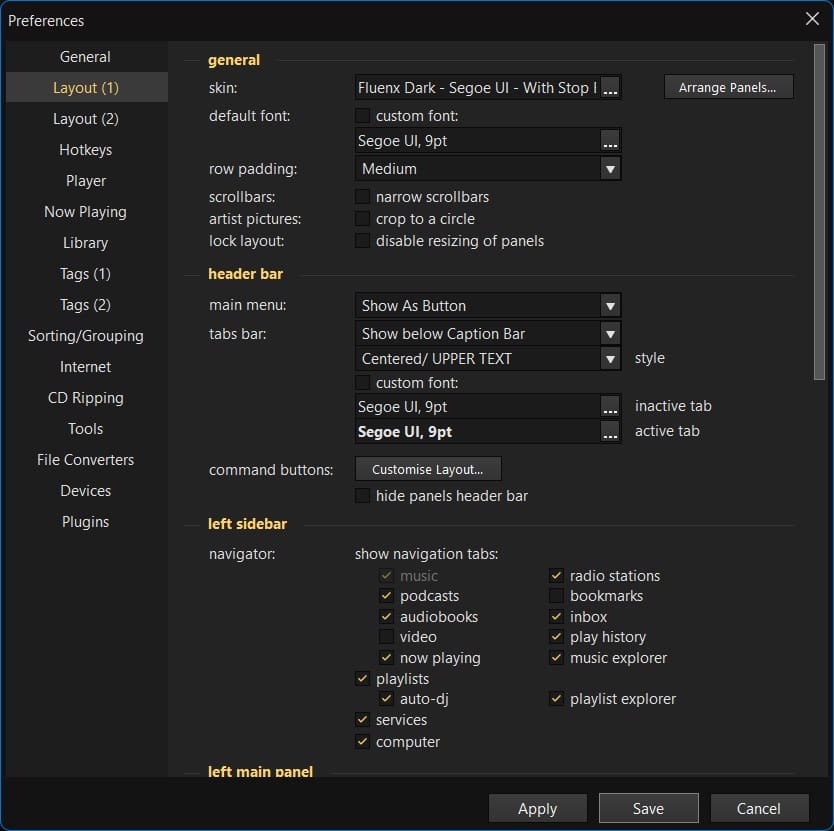
You can check out how my skin and customizations look below compared to the default skin and layout. You can also find a copy of the export file for my panel arrangement here if you like how mine is done. Use the MusicBee menu to import it and you’re good to go!




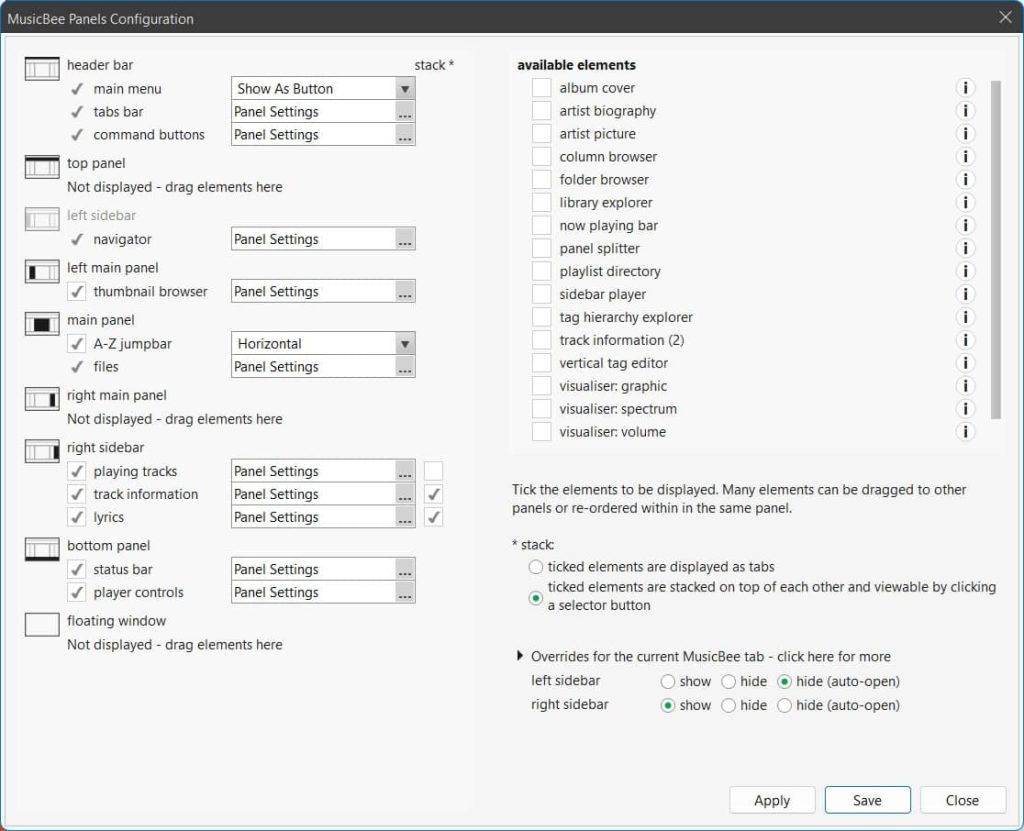

Plugins:
On top of supporting existing Winamp plugins, there are many plugins available for MusicBee. I’ll focus on the ones I use the most.
- Beenius: This plugin allows you to download lyrics from Genius, allowing you to display them in a panel in the main interface.
- MusicBee Remote Plugin: This allows me to control MusicBee from my Android smartphone. I use this feature with the next plugin…..
- UPnP/ DLNA device support: Allows MusicBee to play to a UPnP device, or for a UPnP device to access it. I have this set up to play to my WiFi soundbar and use the remote app on my phone to control the music playback.
Audio Playback
This section will be rather short as there isn’t too much to say here, but I wanted to show how MusicBee handles audio output.
Navigate to the “Player” section in the Preferences and at the very top is where you will find the audio player options. As you can see, it supports pretty much any output type. In my case, it detects the ASIO driver I have installed, as well as my WiFi soundbar that is configured by the UPnP plugin. If you have multiple audio devices connected, you can select it here.
You also have the Equaliser & DSP button at the bottom. Personally, I never use this as any EQ I do is handled by an external DAC/Amp (such as the Qudelix T71) or by PEACE with Equalizer APO (check out my guide of it here).
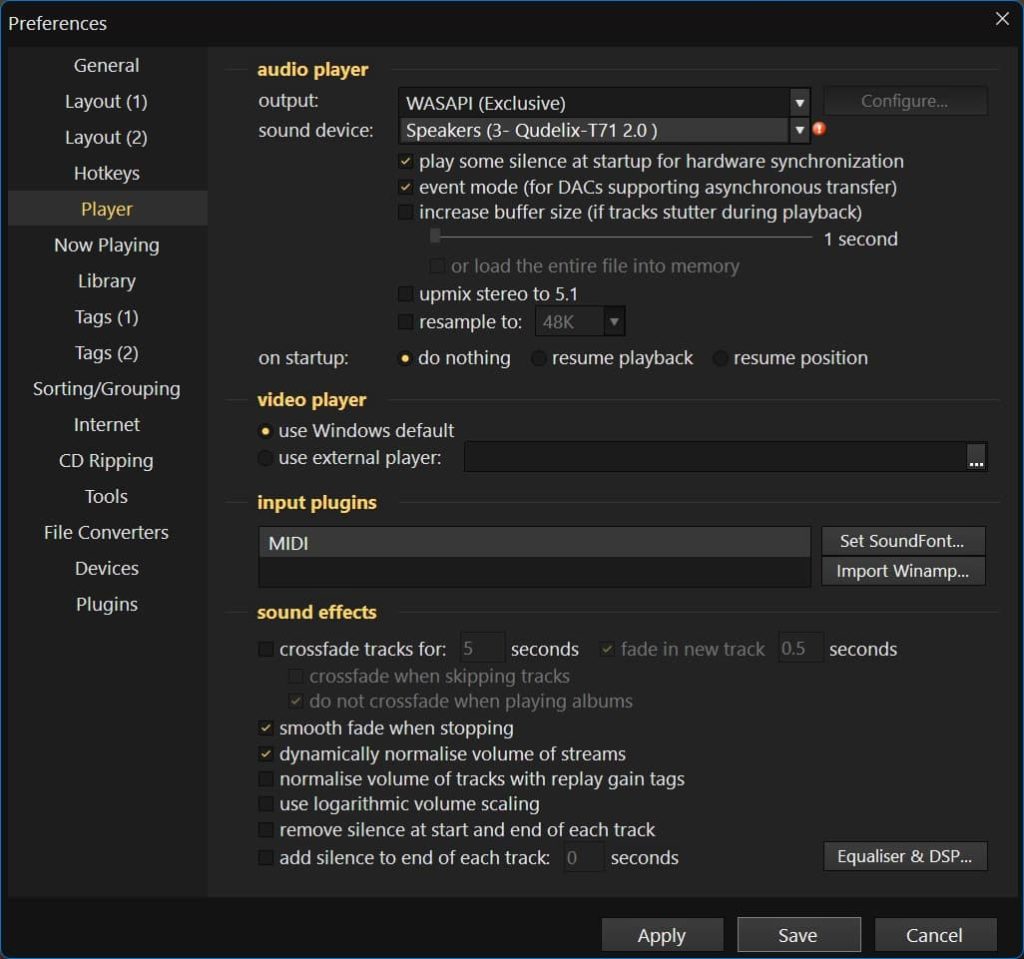
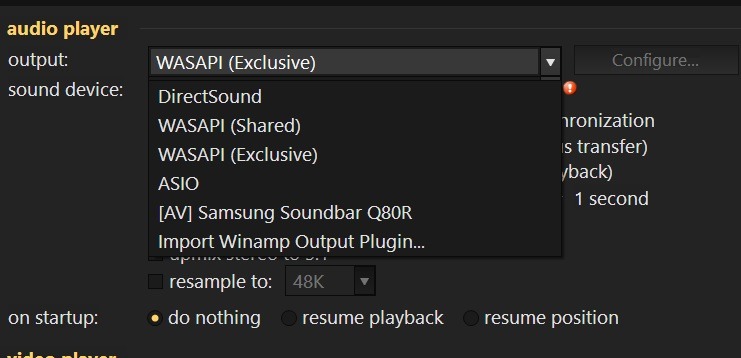

Throughout the course of this MusicBee guide, I think you have seen that MusicBee has proven itself to be a powerhouse for music management and playback. Beyond its practical features, MusicBee fosters a sense of community through its add-ons and user forums, allowing users to engage, contribute, and enhance their experience further. The implications of all this are clear: MusicBee is not merely a music player, but a holistic music management ecosystem that enriches the listening experience on every level. As it continues to evolve with user input and technological advancements, MusicBee sets the bar high for what we can expect from music software, making it a top recommendation for any Windows user looking to elevate their music library experience.
If you like this guide, be sure to check out our other guides.
Also be sure to check outour buying guidesto help you get the best audio experience possible!